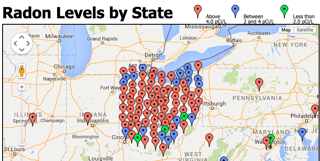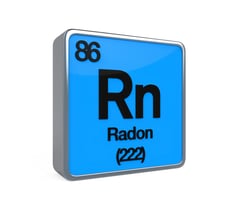What Is Radon Gas?
Many people remain unaware of the potential dangers associated with exposure to radon gas, despite its prevalence and serious health risks, and thus, underestimate the health effects and symptoms of radon exposure. 
Radon gas, although colorless, odorless, and tasteless, poses a significant threat when present in high concentrations. It permeates the air we breathe and the water we consume, presenting health hazards that cannot be detected through our senses alone.
This radioactive gas is naturally formed through the decay of uranium, a process that occurs in soil and rock formations worldwide.
Regions abundant in granite concentrations often exhibit heightened levels of radon gas. Through natural decay, this gas is released from the soil and rock into the atmosphere and water sources, both underground and on the surface.
Understanding the origins and risks associated with radon gas is crucial for safeguarding public health and promoting awareness of potential hazards in our environment. Exposure to high indoor radon levels has been linked to increased lung cancer deaths, making it imperative to address this issue effectively - with the first step being understanding the necessity of radon mitigation and how it can help protect your loved ones.
Curious about what Radon has to do with you and your home? Read our blog post "Radon: The Silent Killer In Your Home"!
Table of Contents
- Is Radon Gas Dangerous?
- Can Walk Out Basements or Slab on Grade Homes have Radon?
- What is a Safe Level of Radon?
- How do I test for Radon?
- How Can I Remove Radon From My Home?
- Contact our Licensed Radon Company
Is Radon Gas Dangerous?
According to the EPA, Radon Gas is the second leading cause of lung cancer in the United States, and it is the leading cause in non-smokers.
Radon gas, commonly correlated with elevated risks of lung cancer, has also been associated with various non-cancerous respiratory diseases, underscoring the significance of mitigating radon exposure and minimizing lung cancer risk associated with radon.
When radon undergoes radioactive decay, it transforms into solid radioactive elements known as radon progeny. These progeny particles tend to attach themselves to dust and airborne particles, which can then be inhaled, further exacerbating the risk from radon and its associated health complications, such as radon poisoning.
This radioactive decay process emits radiation that can damage the DNA within the body's cells. Prolonged exposure to high concentrations of radon, originating from uranium in rock beneath buildings, can trigger a phenomenon known as mutagenesis, wherein the damaged cells replicate, significantly affecting cellular activity within lung tissues and elevating the likelihood of contracting lung cancer.
It's crucial to address radon exposure promptly to mitigate the risk of inhaling radioactive particles and potential health hazards.
Understanding how radon infiltrates homes is essential for effective mitigation strategies. Radon's entry routes into a home include various pathways, including:
- Openings around sump pumps
- Cracks in the foundation
- Crawl spaces
- Floor drains
- Well water
By addressing these potential entry points, individuals can take proactive measures to reduce the risk of radon exposure within their living spaces and mitigate associated health risks.
Can Walk Out Basements or Slab on Grade Homes have Radon?
It's a common misconception that walk-out basements or slab-on-grade homes are immune to elevated levels of radon. However, this assumption couldn't be further from the truth.
Radon, originating from the soil, can infiltrate these structures just as easily as any other. All it takes is the presence of radon in the soil, along with minor openings in the slab, and a temperature differential where the indoor air is warmer than the outdoor air.
This scenario creates an ideal environment for radon entry, regardless of the type of foundation. Understanding this crucial point is essential for homeowners, builders, and real estate professionals alike, as it underscores the importance of radon testing and mitigation strategies in all types of residential structures.
What Is A Safe Level Of Radon?
When it comes to radon exposure, it's crucial to acknowledge that there is technically no safe level. Even though radon naturally exists in the open air, certain concentrations can pose significant health risks.
The Environmental Protection Agency (EPA) has established a recommended action level of 4.0 pCi/L (picocuries per liter). However, it's essential to recognize that this doesn't imply safety; rather, it indicates that radon levels in the home have reached a hazardous threshold, necessitating immediate action for mitigation.
Moreover, radon moves differently in water and soil, so levels of radon will vary depending on the source. The World Health Organization (WHO) has conducted extensive research, prompting them to lower their recommended action level to 2.7 pCi/L. This adjustment underscores the severity of the issue, as even relatively low levels of radon can pose long-term health risks with continued exposure.
The findings of WHO's research highlight the importance of proactive measures to address radon levels in residential environments. By staying informed about average radon levels and implementing appropriate mitigation strategies, individuals can safeguard their health and well-being from the harmful effects of radon exposure.
How Do I Test For Radon?
When it comes to testing for radon in your home, there are several approaches you can take to ensure accurate results and peace of mind.
-
DIY Radon Test Kits: One standard method is to conduct the test yourself by purchasing a radon test kit. These kits are typically designed for either short-term or long-term tests. Short-term tests usually last for about 48 hours and are placed in the lowest level of your home, such as the basement. Once the testing period is complete, you'll mail the kit to a radon testing lab for analysis. This method provides a convenient and cost-effective way to gauge radon levels in your home.
-
Professional Radon Testing Services: Another option is to enlist the services of a licensed radon testing company. These specialists utilize advanced continuous monitoring systems that measure radon levels hourly while the device is in your home. This method offers real-time monitoring and expert analysis of radon levels. After the 48-hour testing period, the technician will interpret the results and provide you with comprehensive insights into your home's radon levels, ensuring thorough understanding and appropriate action if necessary.
Whether you opt for a DIY approach or enlist professional assistance, conducting regular radon tests using either short-term or long-term methods is essential for maintaining a healthy indoor environment and mitigating potential health risks associated with radon exposure.
How Can I Remove Radon From My Home?
Upon discovering elevated radon concentrations within your home, it's crucial to take immediate action by reaching out to a licensed radon contractor. These experts possess the knowledge and tools necessary to address the level of radon exposure and maintain safe indoor levels.
A radon reduction system is essential for mitigating radon gas levels in residential properties. At Radon Eliminator, our team of specialists is committed to delivering comprehensive mitigation services customized to your specific requirements.
Our mitigation process entails installing a ventilation fan in your basement or crawlspace. This fan effectively extracts radon gas from beneath the foundation of your home and safely vents it outdoors. By implementing this cutting-edge system, we significantly reduce radon levels within your living space, ensuring the safety of your household.
With Radon Eliminator, you can rely on the expertise of our specialists to mitigate radon gas effectively and restore tranquility within your home. Contact us for professional assistance in addressing your radon concerns and maintaining a healthier indoor environment for you and your loved ones.
Contact a Radon Testing and Mitigation Company
If you've never had your home tested for radon, now is the time to take action. Acting promptly is essential, as elevated radon levels can lurk in any Ohio home, regardless of its age or location.
Rest assured, our team at Radon Eliminator, Akron's trusted radon company, is equipped with the expertise and licensure from The Ohio Department of Health to provide comprehensive radon testing and mitigation services. We understand the importance of safeguarding your family's well-being from the presence of radon gas and take pride in offering professional solutions to address radon concerns and reducing elevated radon levels in a variety of residential and commercial settings.
Our Radon Professionals are committed to making radon testing and mitigation accessible to all homeowners and businesses.
That's why we offer discounted rates for radon testing and provide free quotes for radon mitigation services. Your safety is our priority, and we're dedicated to ensuring that cost doesn't hinder you from taking proactive steps to protect your home.
Ready to prioritize your family's health? Schedule your radon testing or request a free mitigation quote by clicking the button below!
We offer Discounted Radon Testing and Free Radon Mitigation Quotes.
To schedule, click on the link below now!





